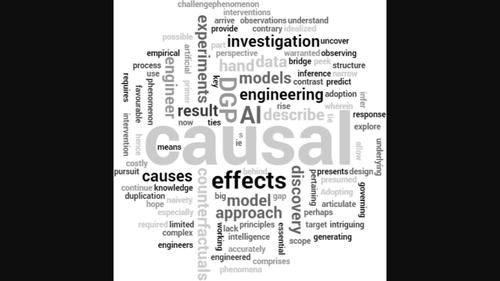当前位置:
X-MOL 学术
›
WIREs Data Mining Knowl. Discov.
›
论文详情
Our official English website, www.x-mol.net, welcomes your
feedback! (Note: you will need to create a separate account there.)
Causality and causal inference for engineers: Beyond correlation, regression, prediction and artificial intelligence
WIREs Data Mining and Knowledge Discovery ( IF 6.4 ) Pub Date : 2024-03-09 , DOI: 10.1002/widm.1533 M. Z. Naser 1, 2
WIREs Data Mining and Knowledge Discovery ( IF 6.4 ) Pub Date : 2024-03-09 , DOI: 10.1002/widm.1533 M. Z. Naser 1, 2
Affiliation

|
In order to engineer new materials, structures, systems, and processes that address persistent challenges, engineers seek to tie causes to effects and understand the effects of causes. Such a pursuit requires a causal investigation to uncover the underlying structure of the data generating process (DGP) governing phenomena. A causal approach derives causal models that engineers can adopt to infer the effects of interventions (and explore possible counterfactuals). Yet, and for the most part, we continue to design experiments in the hope of empirically observing engineered intervention(s). Such experiments are idealized, complex, and costly and hence are narrow in scope. On the contrary, a causal investigation will allow us to peek into the how and why of a DGP and provide us with the essential means to articulate a causal model that accurately describes the phenomenon on hand and better predicts the outcome of possible interventions. Adopting a causal approach in engineering is perhaps more warranted than ever—especially with the rise of big data and the adoption of artificial intelligence (AI); wherein AI models are naivety presumed to describe causal ties. To bridge such knowledge gap, this primer presents fundamental principles behind causal discovery, causal inference, and counterfactuals from an engineering perspective and contrasts that to those pertaining to correlation, regression, and AI.This article is categorized under: Application Areas > Industry Specific Applications Algorithmic Development > Causality Discovery Application Areas > Science and Technology Technologies > Machine Learning
中文翻译:

工程师的因果关系和因果推理:超越相关性、回归、预测和人工智能
为了设计新材料、结构、系统和工艺来应对持续存在的挑战,工程师寻求将原因与结果联系起来并了解原因的影响。这种追求需要进行因果调查,以揭示数据生成过程(DGP)控制现象的底层结构。因果方法得出因果模型,工程师可以采用该模型来推断干预措施的效果(并探索可能的反事实)。然而,在大多数情况下,我们继续设计实验,希望能够凭经验观察工程干预措施。此类实验是理想化的、复杂的且成本高昂,因此范围狭窄。相反,因果调查将使我们能够了解 DGP 的方式和原因,并为我们提供阐明因果模型的基本手段,该模型可以准确描述现有现象并更好地预测可能干预措施的结果。在工程中采用因果方法也许比以往任何时候都更有必要——尤其是随着大数据的兴起和人工智能 (AI) 的采用;其中,人工智能模型被认为描述因果关系是天真的。为了弥补这种知识差距,本入门从工程角度介绍了因果发现、因果推理和反事实背后的基本原理,并将其与相关、回归和人工智能相关的原理进行了对比。本文分类如下: 应用领域 > 行业特定应用 算法开发 > 因果关系发现 应用领域 > 科学技术 技术 > 机器学习
更新日期:2024-03-09
中文翻译:

工程师的因果关系和因果推理:超越相关性、回归、预测和人工智能
为了设计新材料、结构、系统和工艺来应对持续存在的挑战,工程师寻求将原因与结果联系起来并了解原因的影响。这种追求需要进行因果调查,以揭示数据生成过程(DGP)控制现象的底层结构。因果方法得出因果模型,工程师可以采用该模型来推断干预措施的效果(并探索可能的反事实)。然而,在大多数情况下,我们继续设计实验,希望能够凭经验观察工程干预措施。此类实验是理想化的、复杂的且成本高昂,因此范围狭窄。相反,因果调查将使我们能够了解 DGP 的方式和原因,并为我们提供阐明因果模型的基本手段,该模型可以准确描述现有现象并更好地预测可能干预措施的结果。在工程中采用因果方法也许比以往任何时候都更有必要——尤其是随着大数据的兴起和人工智能 (AI) 的采用;其中,人工智能模型被认为描述因果关系是天真的。为了弥补这种知识差距,本入门从工程角度介绍了因果发现、因果推理和反事实背后的基本原理,并将其与相关、回归和人工智能相关的原理进行了对比。本文分类如下:






























 京公网安备 11010802027423号
京公网安备 11010802027423号